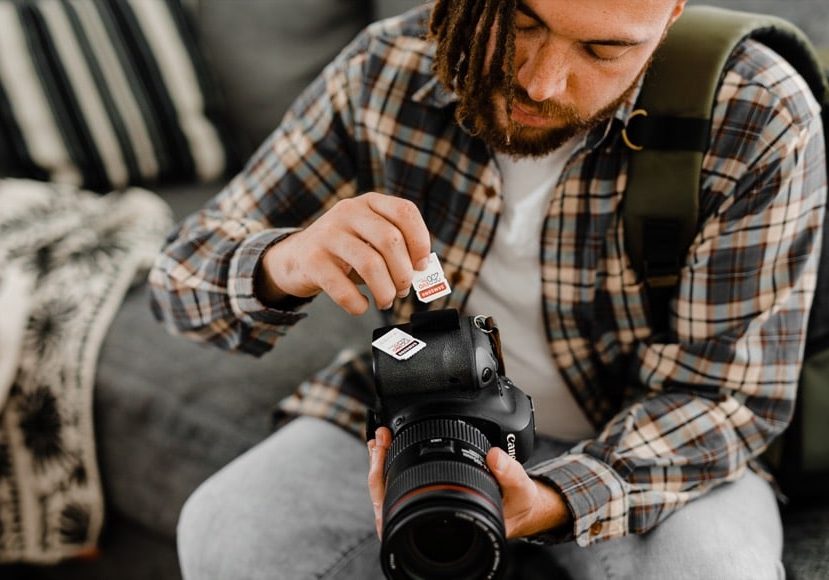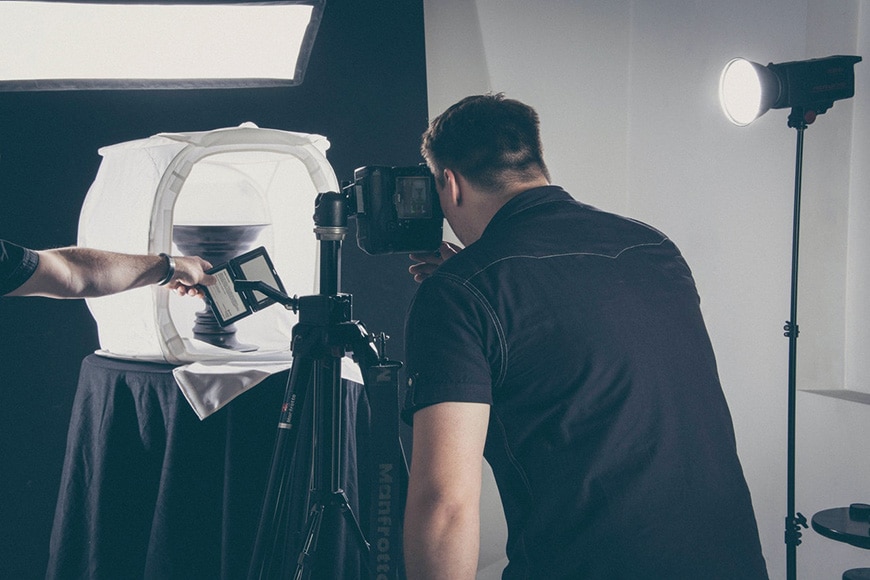
How to Get Work Via Freelance Photography
Want to become a Freelance Photographer? Great idea! Discover 10 handy tips, plus 36 places to find freelance photography jobs (when you have NO experience!)
Learn | Photography Guides | By Ana Mireles
Becoming a freelance photographer is a great way to turn your passion into your business.
With freelance photography, you’ll be able to choose the type of photography that you want to do and plan your own schedule. You can be your own boss!
It sounds amazing, right? It is, but it can be hard to reach that point of stability and be successful.
Take a look at these ten recommendations we put together to help you on your way to becoming a freelance photographer.
We know most people are uncertain about making the decision because they don’t know how they will find freelance photography jobs.
That’s why in this article, you’ll also find a list of places to find potential clients, generate passive income from your photos, and advertise your services.
Freelance photography could be the start of something wonderful for you here in 2024, so let’s dive right in!
What is Freelance Photography?
Freelance photography is the act of providing photos on a short or longterm contract basis to different clients or taking photos as a self-employed photographer.
A freelance photographer is someone whose job is to make photographs, but who’s not an employee of a company. They work by the project – this can be mean just one photo or a full semester; it’s not about the time or the amount.
As a freelance photographer, you work for your client, not your employer – because you’re self-employed. This means that you have the freedom to work with multiple customers, decide your own terms and pricing.
Of course, freelance photography also comes with responsibilities. You’ll have to issue invoices for your clients, declare taxes for them, and take care of your own medical insurance, camera insurance, pension funds, etc.
You also still need to market yourself through your website, portfolio, social media and traditional print marketing. A lot of freelance photography jobs are still found via word of mouth or by simply looking on job boards.
How to Become a Freelance Photographer: 10 Tips
Browse any online photography forum, and the same question keeps popping up: How do I become a freelance photographer with no experience?
To help you out with this conundrum, here are our top 10 tips to becoming a successful freelance photographer in 2024, even if you’ve never made money via your photography before.
1. Do some market research

Credit: Andrea Piacquadio
Doing something because you like it works well for a hobby, but it’s not enough to make a living out of it. Every business or product needs clients to be successful and grow.
To find out if the freelance photography you offer has any demand, you need to gather information about the current market – that’s called market research.
There are different things that you need to find out as part of your research…
First, who’s your main target? When you understand who your client is, you’ll know what are they looking for and make sure your services cover it. You’ll also know where to place your advertising to reach your target audience.
Secondly, you need to research what’s already on the market. By knowing what’s your competition, you’ll know the average costs for similar freelance photography jobs, services and products in your area.
You’ll also be able to separate yourself from the rest; is it your customer service? Your price? Your experience? Why should a client choose you over another freelance photographer?
Once you have this information, you can better refine your niche, improve your services to meet their needs and make sure you stand out in a competitive market.
2. Create a business plan

Credit: Startup Stock Photos
A business plan is a guide or a roadmap to make your freelance photography business grow and make a profit.
How Much Do You REALLY Know About Photography?! 🤔
Test your photography knowledge with this quick quiz!
See how much you really know about photography...

First of all, it needs to define what is your main product or service. Don’t just say photography – that’s kind of a given – be as specific as you can.
For example, if you want to specialize in portrait photography – is it going to be family portraits or corporate ones? If you want to do events photography – do you mean weddings or concerts or corporate events?
Now that you know what it is, define why is it special? In other words, why is it different from your competitors? This comes from analysing other freelance photography professionals (in the market research phase) and understanding your own weaknesses and strengths.
Based on the previous considerations, decide how much you need to spend and how much you can charge. The difference between income and expenses is the amount of money that you’ll be earning. You can then make financial projections to determine how much the business can grow.
Finally, you’ll need to design a photography marketing strategy to make things happen. This needs to be based on your target client and your budget.
Keep in mind that this is a rough outline for a business plan as a freelance photographer. You can search for a professional consultant to make yours, especially if you need to apply for a loan or look for investors.
3. Build a strong portfolio

Credit: Anton Gofman
Your portfolio is your presentation card. More than a CV or recommendation letters from previous employers, what matters most in a photography business is your portfolio.
The clients want to see before anything else the type of photography that they can expect from you. They’ll inquire later about your experience, if you’re reliable, etc., but they won’t get to that part if they are not convinced about your freelance photography work.
Before you start visiting potential clients, make sure you have a strong portfolio that can open the doors for you. Most beginner photographers wonder how to make a portfolio if they haven’t had any clients yet.
Let me put you at ease; it doesn’t matter. The images in your portfolio need to show what you’re capable of doing and not necessarily if you have done it for big brands – at least not at the beginning.
You can do photographic projects by yourself with the specific purpose of creating a portfolio. Remember that you’re showcasing your photography skills as well as your creative vision.
You should also read our guide on how to create a photography portfolio.
4. Diversify

Credit: Alex Simpson
One key aspect of surviving in the freelance photography business is diversification. I don’t mean that you need to have a full-time job on top of your freelancing – unless you have to.
I also don’t mean that you should take on every type of photography in the industry – that would actually cause more damage than good.
What I suggest is that you have different sources of income within your niche.
For example, if you want to specialize in travel photography, you can have income from editorial projects, selling fine art prints; selling your images on stock photography websites; offer workshops; organize photo tours.
That way, if one of those areas is not thriving, it can be compensated by the others, and you’ll always have work.
5. Build a social media presence

Credit: Cottonbro
Social media can be used in different ways; for some freelance photographers, it’s key to their success – for others, not so much.
You might not like the idea of posting five times a day, sharing your life in Instagram Stories and going the extra mile to reach thousands of followers – and that’s OK.
Every person has different personalities, and every business has different strategies. However, I strongly recommend that you do have a social media presence.
Even if you don’t use social media to gain visibility, you should use it for trustability. Most people search online before hiring a service or buying a product. On social media, people can leave comments and rankings, making new clients more confident about you.
Obviously, if you are the type of person that enjoys sharing on social media, you can use these platforms as part of your marketing strategy.
6. Don’t underestimate offline marketing

Credit: Karolina Grabowska
Internet is a wonderful tool. Everyone can have a photography portfolio website, Linkedin and Instagram accounts and advertise their services at very low fees. Do you know what the downside is?
Everyone can have a portfolio, a LinkedIn account and advertising, and standing out can be difficult. There’s a huge amount of freelance photographers out there, and many of them target the same potential clients as you.
While it’s important to have an online presence, look at freelance photography job boards online and overall use technology to your advantage, don’t forget about the offline methods.
Depending on your speciality, you might take different approaches. If you do pet photography, consider distributing flyers in your neighbourhood and leaving them at the vet’s clinic.
If, instead, you do product photography, call the companies that interest you and ask for a meeting or do a follow-up call after sending your portfolio.
7. Word of mouth is priceless

Credit: Flo Dahm
Whenever a client is satisfied, they will come back, and they will recommend you. That’s the best publicity you can ever have, and it can’t be bought.
Make sure you’re doing quality work, that you are treating your freelance photography jobs and clients with respect, and that you’re fulfilling – or even better, exceeding – their expectations.
That’s the best way to success as a freelance photographer here in 2024.
8. You have to spend money to make money

Credit: Harrison Haines
Have you ever heard this expression? You have to spend money to make money. I don’t know if that’s true in every industry, but it certainly is in a freelance photography business.
You can start with the gear that you have, making gigs for friends and family. That’s fantastic! This is a great way to gain confidence, help you build a portfolio and offer you the chance to learn.
If you want to grow and get more and bigger clients, you should invest in your business. Depending on the kind of photography that you do, this might mean different things…and budgets.
If you do wildlife or sports photography, you don’t need a photography studio (at least not as a priority), but you will have to upgrade your photography equipment and even invest in copyrights – see: how much does it cost to copyright a photo?
For other photography types, such as wedding photography, the investment needs to go into advertising, and attending photography trade shows and specialized fairs like wedding expos.
In summary, you do need to invest if you want to boost your photography career.
9. Learn to multitask

Credit: Kal Visuals
Being a freelance professional photographer doesn’t mean just taking photos. You become a one-person business; you’ll be the secretary as well as the boss!
As a freelance photographer, there are many things that you’ll need to do that doesn’t necessarily relate to photography. You have to do your own marketing, customer service, accounting, etc.
Then, of course, all the photographic projects you’ll hopefully have. While you’re pitching to a new client, another one is due to deliver their files, and another one is in the process of selection.
So, when you’re a freelance photographer, you should be able to multitask. Not to mention, learn a new skill or two. You might have to take some web design lessons or attend a social media management webinar.
Once your business has grown, and you’re making enough profit – then you can start hiring people to help you with all the other tasks and focus more (or exclusively) on your photography.
10. Be patient and persevere

Credit: William F Santos
This is tough advice to follow, but it’s probably the most important. Things don’t just happen overnight, regardless of how talented you might be.
To make a living as a freelance photographer, you’ll need to work hard, and it will take some time. If, at first, you can’t dedicate full-time to freelancing because you’re not making enough money out of it – don’t give up.
It can be done, and it’s really fulfilling. So stick to it, be very critical about your work and your services so that you can improve wherever you need it, and I’m sure you’ll find success with freelance photography.
36 Places to Find Freelance Photography Jobs

Credit: Pixabay
There are two ways to find jobs as a freelancer: you can either respond to job offerings or offer your services and products.
You can decide which approach is better for you – for most professionals, it’s a combination of both.
Here’s a list of places where you can find listings and advertise easily while staying on budget.
1. Facebook – many people do not know this, but Facebook has a job searching engine. Any Facebook page can post a freelance photography jobs offer, and you can filter the listing by location, industry or type of job. You can also use Facebook to network within photography groups to share gigs, ask for tips, etc.
2. LinkedIn – this is a social media specifically designed to make work connections. You can follow companies that you’re interested in, search for freelance photography jobs postings, and mark your profile as Open for Work so that recruiters can find you.
3. Instagram – this is the perfect platform to showcase your work and advertise your services for free. You can have a personal account, a business account and even a shop where you can sell your prints.
4. Fiverr – here you can offer your services and set your starting price or package deals. People who need your services will pay Fiverr in advanced, and you’ll get paid by Fiverr after delivering the service – they will take a 20% cut as an agency fee.
5. Zenfolio – another choice for a portfolio website builder where you can showcase your work to attract clients and sell your work.
6. Flexjobs – on this website, you’ll find all sorts of freelance photography jobs that you can apply for. It’s free to browse, but you need a paid subscription to apply and access the full job listing.
7. Obeo – if you make real state photography, here you can find high-quality assignments.
8. Thumbtack – after creating your profile, you can bid for different job offerings. If the clients are interested, they will contact you. You only have to pay if a client responds to your bidding.
9. Getty Images – Getty images is probably the most famous site for stock images. To become a contributor, you have to download their app, upload 3-6 photos and wait for their answer. No hassle at all – but you need to have high-quality work to be accepted.
10. Unsplash – this might sound like a strange suggestion since this is a website where photographers give their images for free use. However, it’s an excellent way to get your name out there and make potential clients notice you. The same recommendation goes for other free stock photography websites such as Pexels.
11. Depositphotos. this is another stock photography website where you can sell your images.
12. Upwork – with a free profile, you can submit proposals to a limited amount of offerings from their job boards. If you need more, you can purchase one of the memberships.
13. Guru – similar to Upwork, you can make bids to the job listings on the website. With a free account, you have a limited amount of bids. To remove the limit, you need a paid account. Also, the agency fee’ charged by Guru for every job you get will vary according to the membership you have.
14. JournalismJobs – if you’re interested in working in journalism and editorial photography, this might be the site for you. Even if it’s available worldwide, there’s a wider listing for U.S. jobs.
15. Airbnb – while everybody knows it to book a vacation rental, not everybody knows that you can also apply to find freelance photography jobs if you specialize in real state, architecture or interior photography. AirBnB photographers are often in high demand.
16. Boom – This start-up connects businesses with photographers. Their areas of speciality are real estate, food, product and corporate photography. They accept photographers from all around the world, but the number of assignments you get will depend on their demand in that specific area.
17. The Creative Loft – this is a very specific job searching website which is a good thing. On the downside, you need a paid membership even to browse the listings, and it’s mostly centred in the U.S.
18. Perfocal – this website is made for people who need a photographer to log in and find one without hassle. As a photographer, you need to accept the website’s pricing as conditions. It’s mainly for UK gigs.
19. Freelancer – this is another bid-per-gig website. If you live outside the U.S., most of the jobs listed are for photo-retouching and post-processing. Photo sessions outside the U.S. are rare.
20. People Per Hour – this bid-per-gig option is mainly dedicated to the UK. Some post-processing jobs are available worldwide, as well as graphic design.
21. Jobs for Artists – Facebook group. This group applies only to art photography gigs; you won’t find jobs for commercial photographers.
22. Booking a Photographer Worldwide – Facebook group – this group is for photographers, but also makeup artists, studio rentals, and other professionals involved in the photography business. You can find gigs or network to build a working team.
23. Virtual Vocations – this website is to find remote work, so you can use it to find post-production and photo-retouching jobs.
24. Get Photography Jobs – this is a job listing search engine where you can filter by keyword and location. It’s completely free, but for that reason, it’s not curated or guaranteed – so be careful because not all jobs will be legit.
25. Craigslist – as a general job search engine, you might not find so many jobs specific for photographers, but there’s always a few – it depends on where you live. Be careful with scammers, though.
26. Indeed – as one of the widest job-seeking websites worldwide, it can be difficult to find photography gigs, but some companies that need steady photographic work -such as e-commerce websites, post job offerings there.
27. Monster – the same as Indeed, it’s a general job search engine where you can find career opportunities.
28. Glassdoor – this is another job worldwide job seeker where you can look for work. The main advantage is the review section to see what it’s like working for a particular company.
29. Hubstaff Talent – this website is dedicated specifically to freelance remote work. You set up your profile and get contacted and paid directly by the companies, not by Hubstaff.
30. Rocketphoto – previously known as Stilio, specializes in real state photography work.
31. Nextdoor – depending on the type of photography you do, you can find work in neighbourhood apps such as Nextdoor. The chances are that one of your neighbours needs a family portrait, pictures of their house because they want to sell it, or photography lessons.
32. Local newspapers – digital is not the only way to go. Your neighbours and local businesses still use newspapers or printed publications to post freelance photography jobs. You can also use it for advertising your services.
33. Smugmug – you can use Smugmug to host your digital portfolio, which is key to find clients. Also, you can sell prints of your images which is a big part of a freelance photographer’s income.
34. Fine Art America – this is another website where you can upload your photos to have a digital portfolio and sell them as prints. You can use it for any type of photography, but it’s mainly for fine art.
35. Shutterstock – selling images in the stock market is part of the income for every freelancer. Shutterstock is one of the biggest websites available for this.
36. Squarespace – this is a very well-known website to build your website, portfolio and online shop.
Freelance Photography FAQs
- What does a Freelance Photographer do?
A freelance photographer is someone who works by assignment or project instead of having a permanent contract. What they do depends on each one – they can dedicate exclusively to photoshoots, or they can also give workshops or sell prints.
- How much does a Freelance Photographer make?
It isn’t easy to give a general answer. It depends on the type of photography, the area where you’re located, your marketing strategy, your skills and experience, and so on.
If the question is: Can you make a living as a freelance photographer? Then the answer is yes; you definitely can. Most photographers work as freelancers.
- Do you need a license to be a Freelance Photographer?
Each country has different rules about freelancers, but the general answer is yes. In most countries, you need to register as a freelancer because you need to issue invoices and pay taxes.
Sometimes there’s a threshold to be considered a freelancer; before that, you might not need any special permissions. It’s best if you research the regulations in your area to avoid getting into trouble.
Final Words
I hope this article was helpful and encouraged you to take the leap and become a freelance photographer.
If you have any doubts or want to share some tips for any aspiring freelance photographers, please share them in the comments section.

Check out these 8 essential tools to help you succeed as a professional photographer.
Includes limited-time discounts.













